Gout and other crystal arthropathies in Canada
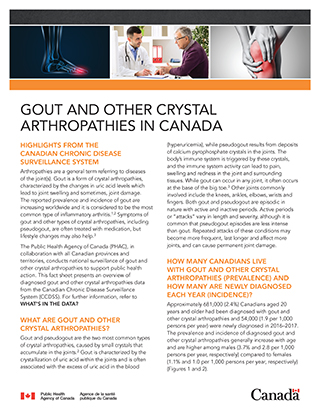
Download the alternative format
(PDF format, 1.9 MB, 6 pages)
Organization: Public Health Agency of Canada
Date published: September 2020
Highlights from the Canadian Chronic Disease Surveillance System
Arthropathies are a general term referring to diseases of the joint(s). Gout is a form of crystal arthropathies, characterized by the changes in uric acid levels which lead to joint swelling and sometimes, joint damage. The reported prevalence and incidence of gout are increasing worldwide and it is considered to be the most common type of inflammatory arthritis.Footnote 1Footnote 2 Symptoms of gout and other types of crystal arthropathies, including pseudogout, are often treated with medication, but lifestyle changes may also help.Footnote 3
The Public Health Agency of Canada (PHAC), in collaboration with all Canadian provinces and territories, conducts national surveillance of gout and other crystal arthropathies to support public health action. This fact sheet presents an overview of diagnosed gout and other crystal arthropathies data from the Canadian Chronic Disease Surveillance System (CCDSS). For further information, refer to What’s in the data?
What are gout and other crystal arthropathies?
Gout and pseudogout are the two most common types of crystal arthropathies, caused by small crystals that accumulate in the joints.Footnote 2 Gout is characterized by the crystallization of uric acid within the joints and is often associated with the excess of uric acid in the blood (hyperuricemia), while pseudogout results from deposits of calcium pyrophosphate crystals in the joints. The body’s immune system is triggered by these crystals, and the immune system activity can lead to pain, swelling and redness in the joint and surrounding tissues. While gout can occur in any joint, it often occurs at the base of the big toe.Footnote 3 Other joints commonly involved include the knees, ankles, elbows, wrists and fingers. Both gout and pseudogout are episodic in nature with active and inactive periods. Active periods or “attacks” vary in length and severity, although it is common that pseudogout episodes are less intense than gout. Repeated attacks of these conditions may become more frequent, last longer and affect more joints, and can cause permanent joint damage.
How many Canadians live with gout and other crystal arthropathies (prevalence) and how many are newly diagnosed each year (incidence)?
Approximately 681,000 (2.4%) Canadians aged 20 years and older had been diagnosed with gout and other crystal arthropathies and 54,000 (1.9 per 1,000 persons per year) were newly diagnosed in 2016–2017. The prevalence and incidence of diagnosed gout and other crystal arthropathies generally increase with age and are higher among males (3.7% and 2.8 per 1,000 persons per year, respectively) compared to females (1.1% and 1.0 per 1,000 persons per year, respectively) (Figures 1 and 2).
Figure 1: Prevalence (%) of diagnosed gout and other crystal arthropathies by sex and age group, Canada,Footnote a 2016–2017
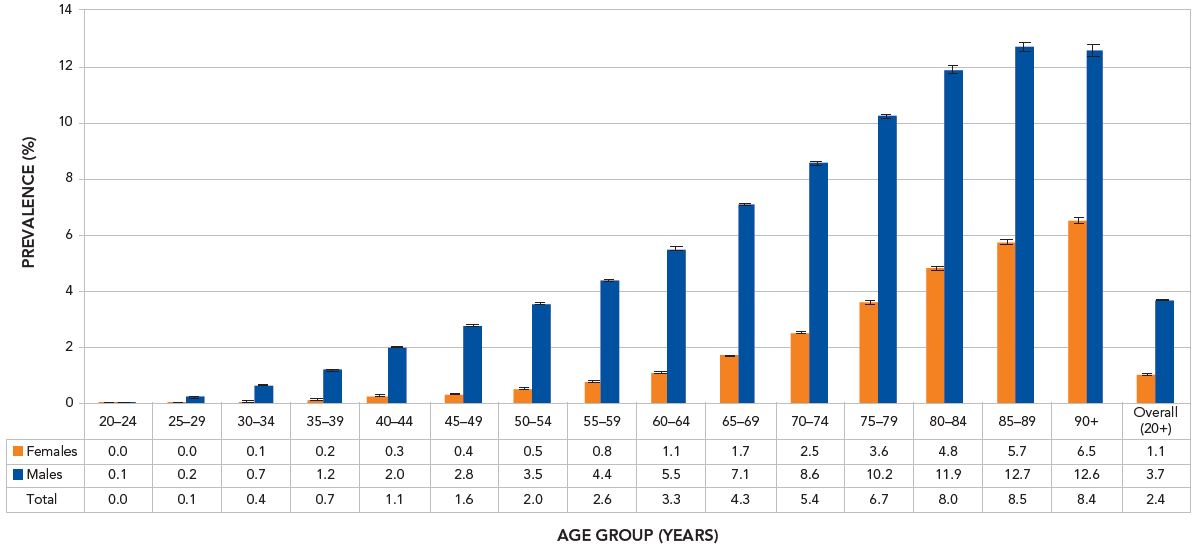
- Footnote a
-
Data from SK were not available for fiscal year 2016–2017.
Notes: The 95% confidence interval shows an estimated range of values which is likely to include the true prevalence 19 times out of 20.
Data Source: Public Health Agency of Canada, using Canadian Chronic Disease Surveillance System data files contributed by provinces and territories, August 2019.
Text description
| Age Group (years) | Prevalence among females for fiscal year 2016-2017 | Prevalence among males for fiscal year 2016-2017 | Total prevalence for fiscal year 2016-2017 |
|---|---|---|---|
| 20-24 | 0.0 | 0.1 | 0.0 |
| 25-29 | 0.0 | 0.2 | 0.1 |
| 30-34 | 0.1 | 0.7 | 0.4 |
| 35-39 | 0.2 | 1.2 | 0.7 |
| 40-44 | 0.3 | 2.0 | 1.1 |
| 45-49 | 0.4 | 2.8 | 1.6 |
| 50-54 | 0.5 | 3.5 | 2.0 |
| 55-59 | 0.8 | 4.4 | 2.6 |
| 60-64 | 1.1 | 5.5 | 3.3 |
| 65-69 | 1.7 | 7.1 | 4.3 |
| 70-74 | 2.5 | 8.6 | 5.4 |
| 75-79 | 3.6 | 10.2 | 6.7 |
| 80-84 | 4.8 | 11.9 | 8.0 |
| 85-89 | 5.7 | 12.7 | 8.5 |
| 90+ | 6.5 | 12.6 | 8.4 |
| Overall (20+) | 1.1 | 3.7 | 2.4 |
Figure 2: Incidence of diagnosed gout and other crystal arthropathies (per 1,000 persons per year), by sex and age group, Canada,Footnote b 2016–2017
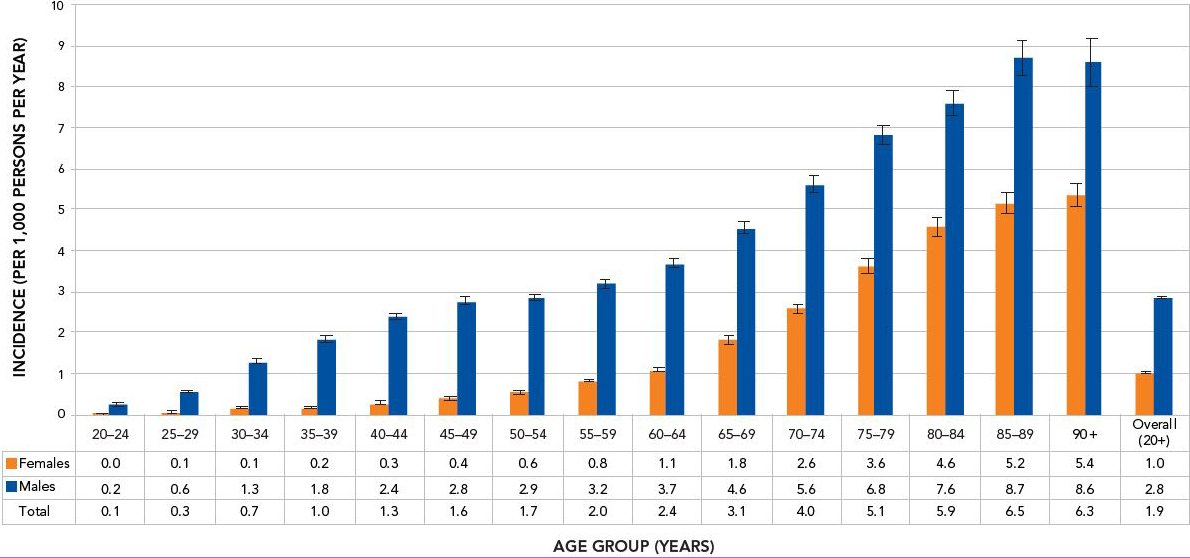
- Footnote b
-
Data from SK were not available for fiscal year 2016–2017.
Notes: The 95% confidence interval shows an estimated range of values which is likely to include the true incidence 19 times out of 20.
Data Source: Public Health Agency of Canada, using Canadian Chronic Disease Surveillance System data files contributed by provinces and territories, August 2019.
Text description
| Age Group (years) | Incidence among females for fiscal year 2016-2017 | Incidence among males for fiscal year 2016-2017 | Total incidence for fiscal year 2016-2017 |
|---|---|---|---|
| 20-24 | 0.0 | 0.2 | 0.1 |
| 25-29 | 0.1 | 0.6 | 0.3 |
| 30-34 | 0.1 | 1.3 | 0.7 |
| 35-39 | 0.2 | 1.8 | 1.0 |
| 40-44 | 0.3 | 2.4 | 1.3 |
| 45-49 | 0.4 | 2.8 | 1.6 |
| 50-54 | 0.6 | 2.9 | 1.7 |
| 55-59 | 0.8 | 3.2 | 2.0 |
| 60-64 | 1.1 | 3.7 | 2.4 |
| 65-69 | 1.8 | 4.6 | 3.1 |
| 70-74 | 2.6 | 5.6 | 4.0 |
| 75-79 | 3.6 | 6.8 | 5.1 |
| 80-84 | 4.6 | 7.6 | 5.9 |
| 85-89 | 5.2 | 8.7 | 6.5 |
| 90+ | 5.4 | 8.6 | 6.3 |
| Overall (20+) | 1.0 | 2.8 | 1.9 |
What are the trends over time?
Between 2007–2008 to 2016–2017, the age-standardized prevalence of diagnosed gout and other crystal arthropathies increased among females (from 0.7% to 0.9%) and males (from 3.0% to 3.6%) (Figure 3). During the same time period, the age-standardized incidence of diagnosed gout and other crystal arthropathies increased from 0.8 to 0.9 per 1,000 persons per year in females and from 2.7 to 2.9 per 1,000 persons per year in males.
Figure 3: Age-standardizedFootnote c prevalence (%) and incidence (per 1,000 persons per year) of diagnosed gout and other crystal arthropathies among Canadians aged 20 years and older, by sex, Canada,Footnote d from 2007–2008 to 2016–2017
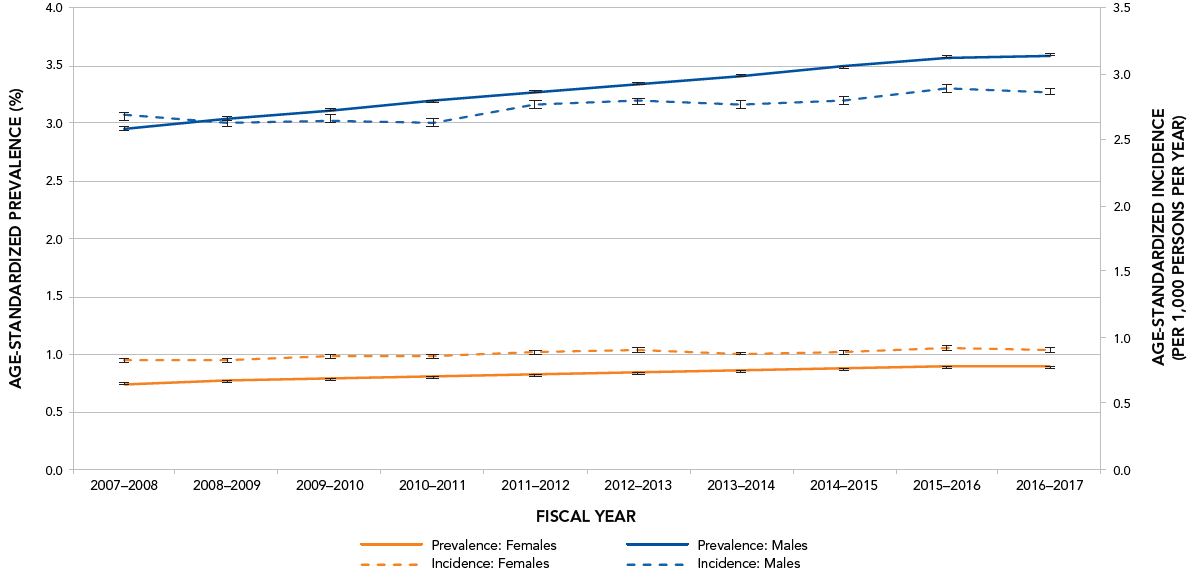
- Footnote c
-
Rates were age-standardized to the 2011 final postcensal Canada population released in 2013.
- Footnote d
-
Data from SK were not available for fiscal year 2016–2017. Data from YT were excluded before fiscal year 2010–2011.
Notes: The 95% confidence interval shows an estimated range of values which is likely to include the true value 19 times out of 20.
Data source: Public Health Agency of Canada, using Canadian Chronic Disease Surveillance System data files contributed by provinces and territories, August 2019.
Text description
| Fiscal Year | Age-standardized prevalence among females aged 20 years and older | Age-standardized prevalence among males aged 20 years and older | Age-standardized incidence among females aged 20 years and older | Age-standardized incidence among males aged 20 years and older |
|---|---|---|---|---|
| 2007-2008 | 0.7 | 3.0 | 0.8 | 2.7 |
| 2008-2009 | 0.8 | 3.0 | 0.8 | 2.6 |
| 2009-2010 | 0.8 | 3.1 | 0.9 | 2.7 |
| 2010-2011 | 0.8 | 3.2 | 0.9 | 2.6 |
| 2011-2012 | 0.8 | 3.3 | 0.9 | 2.8 |
| 2012-2013 | 0.8 | 3.3 | 0.9 | 2.8 |
| 2013-2014 | 0.9 | 3.4 | 0.9 | 2.8 |
| 2014-2015 | 0.9 | 3.5 | 0.9 | 2.8 |
| 2015-2016 | 0.9 | 3.6 | 0.9 | 2.9 |
| 2016-2017 | 0.9 | 3.6 | 0.9 | 2.9 |
What are the mortality rates (due to any cause of death) among Canadians with or without gout and other crystal arthropathies?
Between 2007–2008 and 2016–2017, age-standardized all-cause mortality rates (i.e. mortality due to any cause) decreased among females with diagnosed gout and other crystal arthropathies (13.6 per 1,000 persons per year to 13.1 per 1,000 persons per year), and among males with diagnosed gout and other crystal arthropathies (13.7 per 1,000 persons per year to 12.2 per 1,000 persons per year) (Figure 4).
Over the surveillance period, the age-standardized all-cause mortality rate ratios (i.e., comparing individuals with, versus without, diagnosed gout and other crystal arthropathies) were relatively stable ranging from 1.9 to 2.2 for females and from 1.3 to 1.4 for males. While rate ratios were similar among females and males, they showed an increase in mortality risk among those with diagnosed gout and other crystal arthropathies.
Figure 4: Age-standardizedFootnote e all-cause mortality rates (per 1,000 persons per year) and rate ratios among Canadians aged 20 years and older with and without diagnosed gout and other crystal arthropathies, Canada,Footnote f from 2007–2008 to 2016–2017
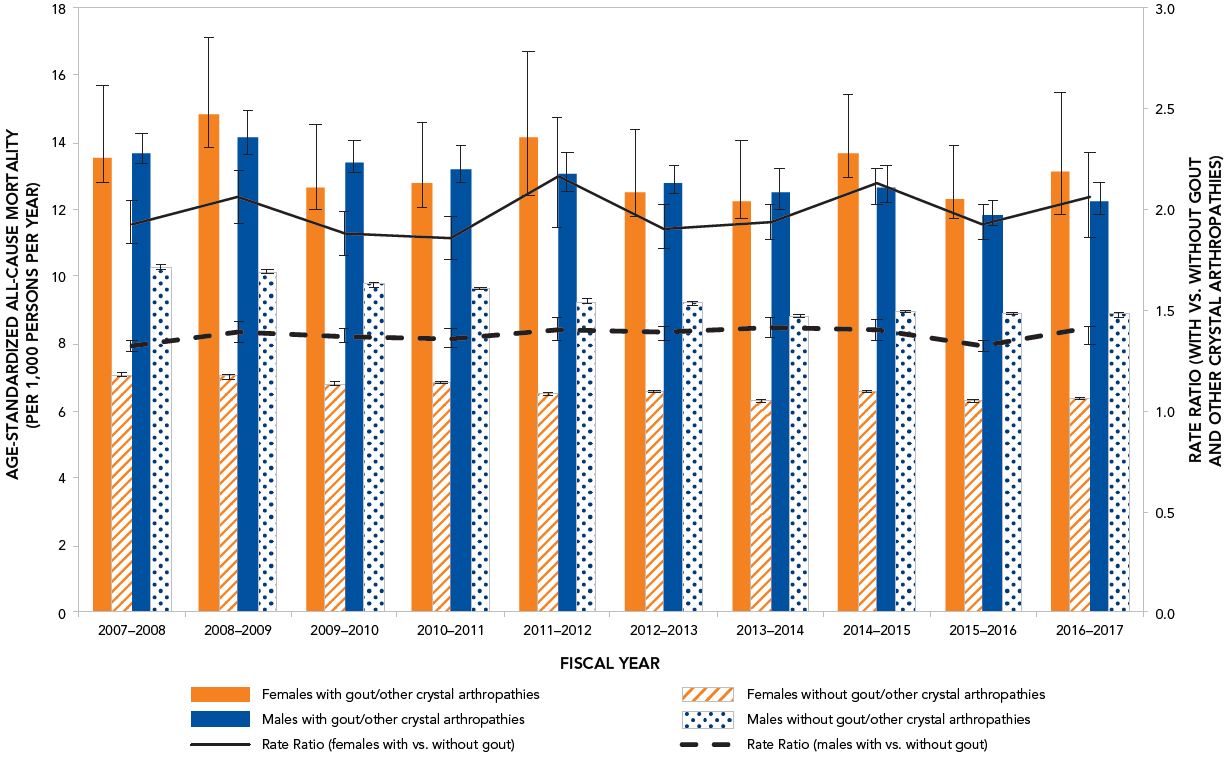
- Footnote e
-
Rates were age-standardized to the 2011 final postcensal Canada population released in 2013.
- Footnote f
-
Data from SK were not available for fiscal year 2016–2017. Data from YT were excluded before fiscal year 2010–2011.
Notes: The 95% confidence interval shows an estimated range of values that is likely to include the true value 19 times out of 20.
Data source: Public Health Agency of Canada, using CCDSS data files contributed by provinces and territories, August 2019.
Text description
| Fiscal Year | Age-standardized all-cause mortality among females aged 20 years and older with diagnosed gout and other crystal arthropathies | Age-standardized all-cause mortality among females aged 20 years and older without diagnosed gout and other crystal arthropathies | Age-standardized all-cause mortality among males aged 20 years and older with diagnosed gout and other crystal arthropathies | Age-standardized all-cause mortality among males aged 20 years and older without diagnosed gout and other crystal arthropathies | Rate ratio among females aged 20 years and older (females with versus without diagnosed gout and other crystal arthropathies) | Rate ratio among males aged 20 years and older (males with versus without diagnosed gout and other crystal arthropathies) |
|---|---|---|---|---|---|---|
| 2007-2008 | 13.7 | 7.1 | 13.6 | 10.3 | 1.9 | 1.3 |
| 2008-2009 | 14.5 | 7.0 | 14.1 | 10.2 | 2.1 | 1.4 |
| 2009-2010 | 12.8 | 6.8 | 13.4 | 9.8 | 1.9 | 1.4 |
| 2010-2011 | 12.7 | 6.8 | 13.1 | 9.7 | 1.9 | 1.4 |
| 2011-2012 | 13.2 | 6.5 | 13.0 | 9.3 | 2.0 | 1.4 |
| 2012-2013 | 12.5 | 6.6 | 12.8 | 9.2 | 1.9 | 1.4 |
| 2013-2014 | 12.3 | 6.3 | 12.5 | 8.8 | 1.9 | 1.4 |
| 2014-2015 | 14.0 | 6.6 | 12.6 | 9.0 | 2.1 | 1.4 |
| 2015-2016 | 12.2 | 6.3 | 11.8 | 8.9 | 1.9 | 1.3 |
| 2016-2017 | 13.1 | 6.4 | 12.5 | 8.9 | 2.1 | 1.4 |
How can gout and other crystal arthropathies be managed?
The development of gout and other crystal arthropathies can be attributed to a number of factors including obesity, diet, alcohol intake, and certain medications. Gout and other crystal arthropathies can be managed with medication and lifestyle changes.Footnote 3Footnote 4 Anti-inflammatory drugs are often taken to reduce pain and decrease joint inflammation.Footnote 5 Self-management strategies include patient education on lifestyle (e.g. awareness of the importance of weight management) and dietary recommendations, to help alleviate symptoms and decrease severity of attacks.Footnote 4Footnote 6
What do national data on gout and other crystal arthropathies tell us?
- The prevalence and incidence of diagnosed gout and other crystal arthropathies are more common among males compared to females and increase with age.
- The increase in mortality risk among individuals diagnosed with gout may be due to the increased presence of comorbidities associated with gout.Footnote 1
Acknowledgements
This work was made possible through collaboration between PHAC and all Canadian provincial and territorial governments and expert contribution from the CCDSS Arthritis Working Group. Results and interpretations reported in this fact sheet are those of the authors. No endorsement by the provinces and territories is intended or should be inferred.
How to learn more
Visit: Canada.ca search "arthritis" or "gout"
Get data: Canadian Chronic Disease Surveillance System Data Tool
Follow us: @GovCanHealth
Like us: @HealthyCdns
More: visit the Arthritis Society
What's in the data?
The data used in this publication are from the Canadian Chronic Disease Surveillance System (CCDSS), a collaborative network of provincial and territorial chronic disease surveillance systems, supported by the Public Health Agency of Canada (PHAC).
The CCDSS identifies chronic disease cases from provincial and territorial administrative health databases, including physician billing claims and hospital discharge abstract records, linked to provincial and territorial health insurance registry records using a unique personal identifier. Data on all residents eligible for provincial or territorial health insurance are captured in the health insurance registries.
While CCDSS data reflect the health status of the Canadian population, they may also reflect changes in data collection methods, coding and classification systems, or clinical and billing practices. These factors must also be taken into consideration when interpreting time trends.
Definition of diagnosed gout and other crystal arthropathies in the CCDSS
Canadians aged 20 years and older are identified as having diagnosed gout and other crystal arthropathies if they have: at least one hospitalization record or at least two physician claims in a five-year period with an International Classification of Diseases (ICD-9 or ICD-10) code for gout and other crystal arthropathies.
References
- Footnote 1
-
Rai SK, Aviña-Zubieta JA, McCormick N, De Vera MA, Shojania K, Sayre EC, et al. The rising prevalence and incidence of gout in British Columbia, Canada: population-based trends from 2000 to 2012. Semin Arthritis Rheum. 2017 Feb;46(4):451–56.
- Footnote 2
-
Kuo CF, Grainge MJ, Zhang W, Doherty M. Global epidemiology of gout: prevalence, incidence and risk factors. Nat Rev Rheumatol. 2015 Nov;11(11):649–662.
- Footnote 3
-
Public Health Agency of Canada (PHAC). Life with arthritis in Canada: a personal and public health challenge. Ottawa (ON): PHAC; 2010 [cited 2019 Mar 20]. Available from: www.canada.ca/content/dam/phac- aspc/migration/phac-aspc/cd-mc/arthritis-arthrite/lwaic-vaaac-10/pdf/ arthritis-2010-eng.pdf
- Footnote 4
-
Khanna D, Fitzgerald JD, Khanna PP, Bae S, Singh MK, Neogi T, et al. 2012 American College of Rheumatology guidelines for management of gout. Part 1: systematic nonpharmacologic and pharmacologic therapeutic approaches to hyperuricemia. Arthritis Car Res (Hoboken). 2012 Oct;64(10):1431–46.
- Footnote 5
-
Van Durme CM, Wechalekar MD, Landewé RB. Nonsteroidal anti-inflammatory drugs for treatment of acute gout. JAMA. 2015 Jun; 313(22):2276–7.
- Footnote 6
-
Engel B, Just J, Bleckwenn M, Weckbecker K. Treatment options for gout. Dtsch Ärztebl Int. 2017 Mar;114(13):215.